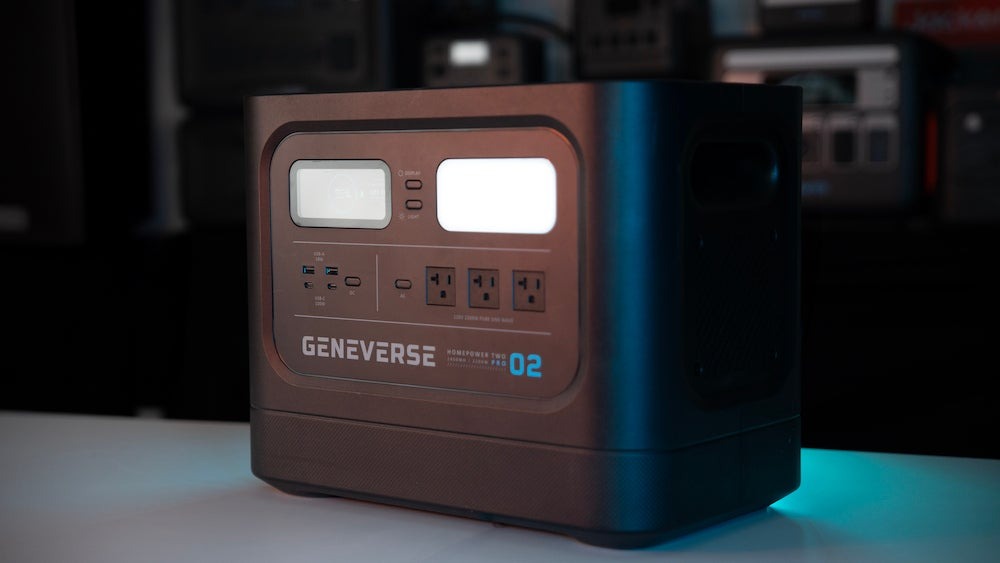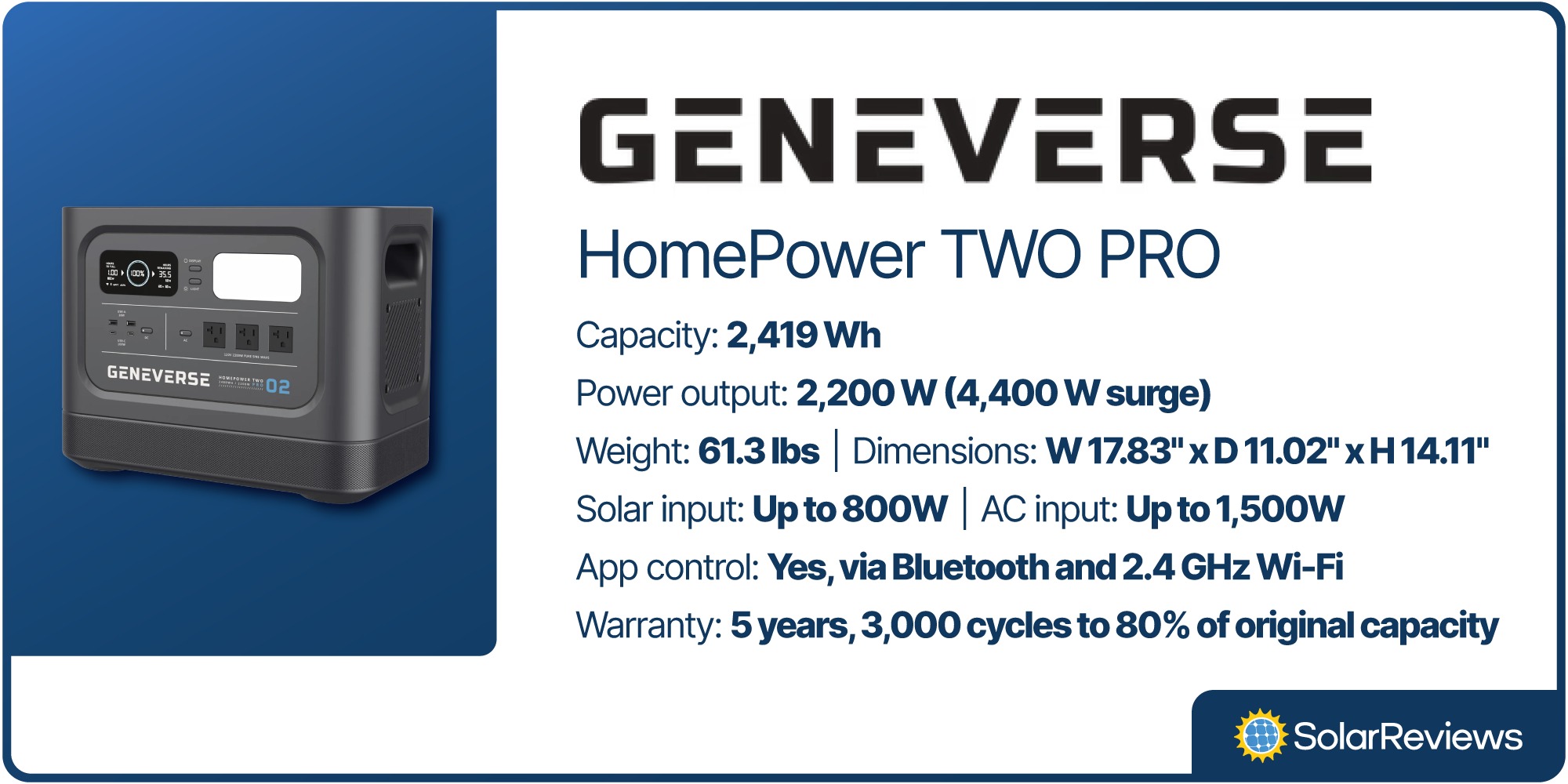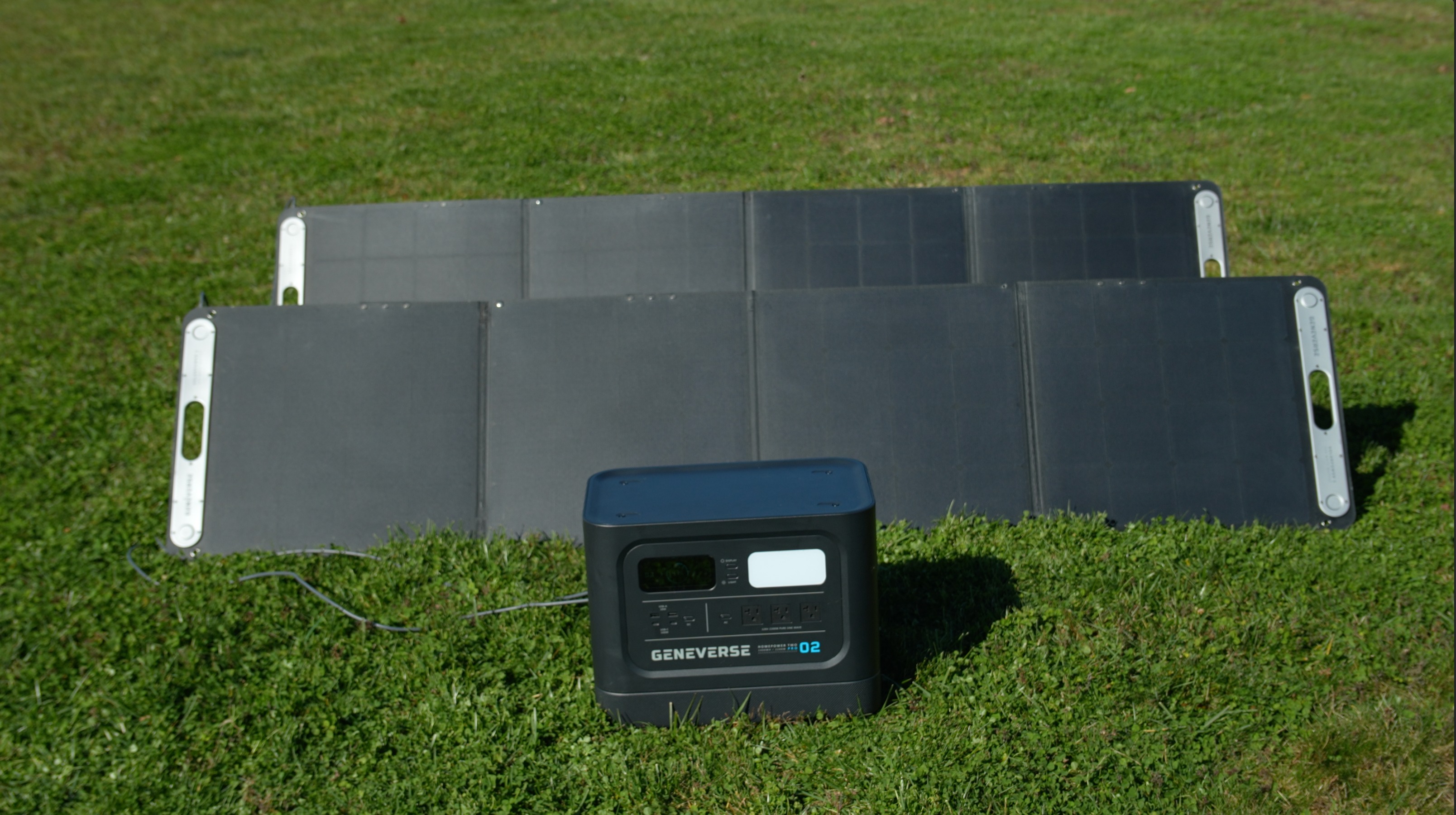Updated 8 months ago
Expert review of the Geneverse HomePower TWO PRO Solar Generator
Written by
Ben Zientara

Wondering if the Geneverse HomePower TWO PRO is the right portable solar generator for you? We put this 2,419-watt-hour battery to the test, pushing the limits of its 2.2-kilowatt output and the capabilities of Genverse’s all-weather solar panels.
Based on its performance during our testing, we recommend the Geneverse HomePower TWO PRO as a good choice for people who want protection from power outages and a way to keep essential appliances like refrigerators, coffee makers, home office devices, and CPAP machines running for hours when the grid is down.
The HomePower TWO PRO at a glance

The Geneverse HomePower TWO PRO is a capable mid-sized backup power source to run some of your key appliances in the event of a power outage. On days when the grid is not in danger of failure, it can also be used to run some power tools and other appliances in areas where no power is available.
In our testing, the Geneverse HomePower TWO PRO did quite well at running essential appliances. We were also able to use the unit to power a small worksite in a part of a home with no power, which was a huge benefit.
We’re impressed with the Geneverse’s maximum power output and energy storage capacity. While it can’t provide whole home backup, it can power your essential appliances and devices for many hours in a power outage. We love that it can charge quickly from the wall or solar panels, and we were impressed by the Geneverse app, which allows you to control the unit over Bluetooth and Wi-Fi. Finally, We appreciate the lithium iron phosphate batteries inside and the 5-year warranty from the manufacturer that should provide a good deal of peace of mind.
We didn’t love the weight of the unit (61 lbs) with no wheels or a handle, nor the exclusion of a 12V DC automotive port, but for a battery that’s meant to be kept close to home, we can forgive these shortcomings.
What the HomePower TWO PRO can do

With a maximum continuous output of 2,200 watts, the HomePower TWO PRO can run a full-sized refrigerator and a microwave at the same time and can handle pretty much any kitchen or bathroom appliance you can throw at it.
The 2,419-watt-hour energy capacity is enough to keep a full-sized refrigerator cold for a full day in a power outage. But, if you choose to keep devices charged and use other appliances like a coffee maker, toaster, and hair dryer, you can run the battery down in 5 to 6 hours.
That’s still enough power to survive most unexpected outages in the United States, which occur 1.5 times per year and last 3 to 4 hours per event, on average. If you’re in an especially outage-prone state like Mississippi, Texas, Oregon, or Louisiana, you can rest assured that the Geneverse HomePower TWO PRO can keep your essential appliances running for a longer time—as long as you don’t need heat or air conditioning.
Running power tools

Many solar generators on the market can keep simple appliances and devices running in a power outage, but with 2,200 watts of continuous output and the ability to surge up to 4,400 watts, the Geneverse HomePower TWO PRO is in an elite category of generators that can put out enough power to run power tools.
Power tools had a lot to do with one of the big tests we put the Geneverse unit through. While a co-worker was remodeling part of his house that had no power, we let the crew use the HomePower TWO PRO over the course of 4 days to run a table saw, compressor, and miter saw without problems. On top of that, they charged their cordless drill batteries and phones, and the Geneverse battery still had 5% capacity remaining when the work was done.
We recommend that you carefully check the wattage requirements of any power tool before using it with a solar generator, but you can rest assured that this battery will be able to run the most common power tools.
Recharging

When the time has come to fill the batteries on the HomePower TWO PRO, you have two options: AC power from the wall or DC power from solar panels.
AC charging is accomplished via a cord plugging into a 3-prong receptacle on the back of the unit (no power bricks, here!), which charges up to 1,500 W at a time. That’s fast enough to refill the battery in just a couple of hours, so you can use the HomePower TWO PRO all day and have it filled up and ready to provide backup power by bedtime.
Solar charging is done through two 8mm barrel jacks in the back of the unit. Each jack can accept up to 400W of solar input (17.5 - 54V DC at up to 10.5A for the technically inclined), for a total of 800W of potential solar input. On a sunny day, the two Geneverse SolarPower 2 panels we tested recharged to unit fully over the course of 8 hours.
Each of them put out up to 200 W under full sun, and two can be wired together in series and plugged into one of the 400W barrel jacks, meaning you can have as many as four SolarPower 2 panels plugged into the HomePower TWO PRO.
Other solar panel brands can be used as long as they meet the input's open-circuit voltage (VOC) requirements, but you might need to purchase a separate MC4-to-8mm adapter to plug them into the Geneverse.
Geneverse HomePower TWO PRO cost and buying options
The Geneverse HomePower TWO PRO comes in at a retail price of $2,299 but can often be found on sale from Geneverse and Amazon. You can also buy the unit as a bundle with two SolarPower 2 panels for $3,299 from the Geneverse website.
These prices are a little high compared to other products on the market. We usually look at solar generators on a dollars-per-watt-hour basis, and the industry average is about $0.85/Wh. At its retail price, the HomePower TWO PRO comes in at $0.95/Wh, or about 12% higher than average.
The SolarPower 2 panels are also expensive. Compared to other leading companies on the market, which offer 200-watt solar panels for about $2 per watt, the Geneverse panels come in at $3.15/W, but it should be noted that Geneverse offers a 5-year warranty, which beats other companies’ 12 to 36 months.
As with any frequently-discounted product, we advise keeping your eyes peeled for deals, especially surrounding well-known shopping holidays like President’s Day, Memorial Day, the 4th of July, and, of course, Black Friday.
How the Geneverse HomePower TWO PRO compares to the competition
You can find several other solar generators on the market that offer around 2,000 watts of power output and 2,000 Wh of storage. Two of the most popular include the EcoFlow Delta 2 Max and the Anker SOLIX F2000.
Here’s a look at some of the key specifications of these three competitors side by side:
| Geneverse HomePower TWO PRO | Anker SOLIX F2000 | EcoFlow Delta 2 Max |
|---|---|---|---|
Energy capacity | 2,419 Wh | 2,048 Wh | 2,048 Wh |
Power output | 2,200 W | 2,400 W | 2,400 W (3,400 W X-Boost) |
Weight | 61.3 lbs | 67.5 lbs | 52.2 lbs |
Dimensions | 17.83” L, 11.02” W, 14.11” H | 20.70" L, 15.50" W, 9.80" H | 19.60" L, 9.50" W, 12.00" H |
Solar input | 800 W | 1,000 W | 1,000 W |
AC input | 1,500 W | 1,440 W | 1,800 W (3,000W X-Boost mode) |
AC outlets | 3 standard outlets | 4 standard outlets, one 30A RV outlet | 6 standard outlets |
DC outlets | 2 USB-A Quick Charge 3.0 ports and 2 USB-C 100W PD ports | 3 USB-C 100W PD, 2 USB-A, 1 car output | 2 USB-C 100W PD, 4 USB-A, 2 barrel 5521 ports, 1 car output |
Warranty | 5 years, 3,000 cycles | 5 years, 3,000 cycles | 5 years, 3,000 cycles |
Recent pricing | $2,299 | $1,599 | $1,499 |
When compared to these two other products, the Geneverse exhibits some benefits and drawbacks. First and foremost, the HomePower TWO PRO outshines its competition in energy capacity with 2,419 Wh compared to the 2,048 Wh offered by both alternatives. Additionally, the Geneverse unit weighs approximately 10% less than the Anker SOLIX F2000, making it more compact.
However, there are some areas where the competition excels. The EcoFlow Delta 2 Max is lighter and more portable than the HomePower TWO PRO. It also offers more AC outputs, better expandability, and higher output (2,400 W vs 2,200). While the Anker SOLIX F2000 may be bigger and heavier, it comes with wheels and a pull handle to help move it around, and its capacity can also be expanded with an add-on battery.
Both the EcoFlow and Anker units surpass the HomePower TWO PRO in terms of solar input capacity (up to 1,000 watts compared to HomePower's 800-watt input). The EcoFlow also charges much faster from AC wall power (up to 3,000 watts).
All in all, each of these batteries has its niche. The Geneverse HomePower TWO PRO stands out as the optimal choice for those seeking a simple battery with substantial storage capacity, especially if mobility is not a priority.
Bottom line: should you buy the HomePower TWO PRO?
The Geneverse HomePower TWO PRO is a good choice for people who want to keep a battery in their home in preparation for outages. Its power output and energy capacity are enough to last for most of a day while using ordinary appliances and charging electronics, and with solar input, it can recharge almost all the way on a nice sunny day.
The HomePower TWO PRO is a quality product from a good brand, with good technology and a good warranty. However, from the prices we’ve seen online, the Geneverse option comes in a bit more expensive than some of its competitors, all of which have their own distinct features that make them worth buying.
What Geneverse has going for it here is a larger overall capacity than some other options. If having that extra bit of juice to keep you going through an outage is worth it to you, then we still recommend the HomePower TWO PRO. And if you can find yourself a HomePower TWO PRO for a similar price to some of the other 2-kWh power stations on the market, it becomes an even better deal.
Ben Zientara is a writer, researcher, and solar policy analyst who has written about the residential solar industry, the electric grid, and state utility policy since 2013. His early work included leading the team that produced the annual State Solar Power Rankings Report for the Solar Power Rocks website from 2015 to 2020. The rankings were utilized and referenced by a diverse mix of policymakers, advocacy groups, and media including The Center...
Learn more about Ben Zientara